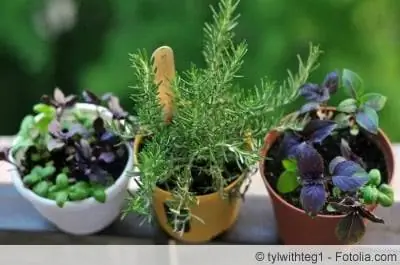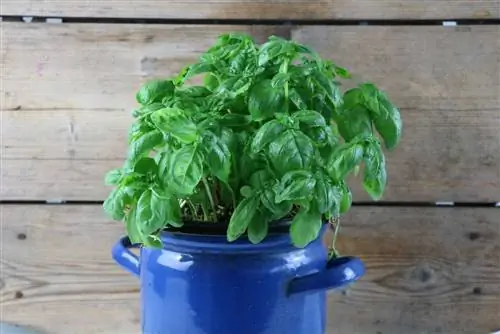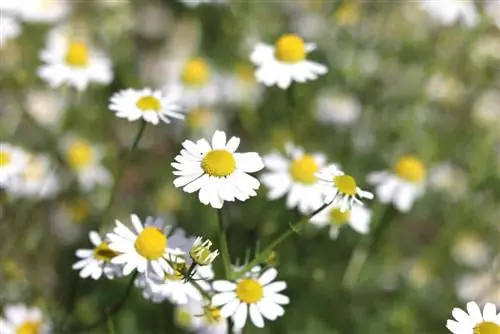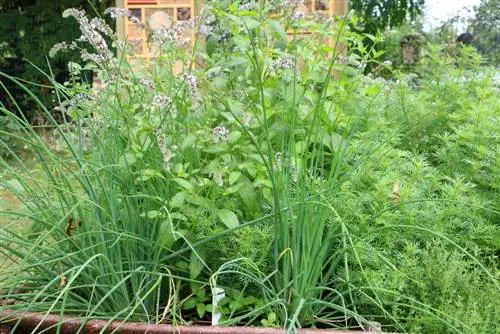- Author admin [email protected].
- Public 2023-12-17 03:39.
- Last modified 2025-01-24 12:45.
Herbs are an ideal addition to the menu and impress with their spicy aroma and hearty taste. Home-grown herbs have a much more intense taste than purchased plants. In order for herbs to grow splendidly in a garden bed or a planter, it is important to ensure that the varieties fit together well and complement each other. Some types of herbs don't get along at all and interfere with each other's development, so that the harvest is extremely poor or even completely absent.
Location requirements
When you grow herbs yourself in order to use them freshly harvested in the kitchen, the question quickly arises as to which of the many varieties can be planted together. Not every type of herb gets along with a chosen neighbor; some herbs hinder each other's growth, cover each other very quickly or have extremely different requirements when it comes to soil conditions. There are a few important things to consider after purchase; the herbs you have purchased must be separated immediately and classified according to the correct categories. This factor is extremely important so that the respective types of herbs feel good right from the start and can thrive. When herbs are stressed, they quickly wither and are no longer usable for cultivation:
- Inform in advance about the compatibility and location requirements of the herbs
- Do not plant herbs too closely, leave enough space for them to develop
- When planting a herb garden, draw an overview plan
- A spiral-shaped herb snail is ideal for cultivation
- Herb spiral offers different location conditions and sufficient distance
- Mediterranean herbs prefer dry and poor soils and lots of sunlight
- Native herbs need moist and nutrient-rich soil, with partial shade
- Watercress and water mint grow well in the water zone
- Cultivate expansive herbs as solitary plants or in individual planters
Annual, biennial and perennial herbs
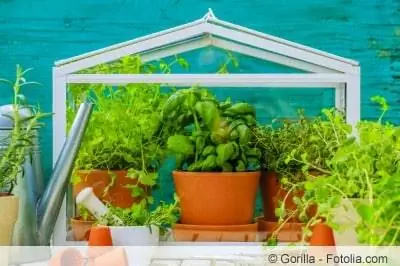
In general, annual herbs should not be mixed with biennial and perennial herbs and it is better not to plant them side by side. Ideally, each category stays completely to itself, because the perennial herb varieties don't appreciate it when they get a different plant neighbor every year. In addition, annual herb varieties thrive much better if they are allowed to move to a new location in the following planting year. With a one-sided monoculture, the soil quickly becomes depleted, which can be prevented with a few tactical considerations:
- Annual herbs: basil, fenugreek, savory, borage, dill, garden cress, nasturtium, chamomile, chervil, coriander, cumin, marjoram, parsley, pimpinella, rosemary, arugula
- Biennial and perennial herbs: wild garlic, wild garlic, mugwort, blood sorrel, watercress, curry herb, tarragon, fennel, coltsfoot, calamus, caraway, garlic, spoonwort, mint, lemon balm, oregano, saffron, sage, sorrel, chives, ribwort plantain, celery, thyme, woodruff, winter cress, lemon balm
Very well-matched herbs
Some types of herbs not only go very well together, but also support the growth of their plant neighbors in the herb bed. Particularly noteworthy are chamomile and basil, which get along well with many other herbs and can even permanently repel pests:
- Rosemary promotes the growth of basil, both are not completely winter-proof
- Chamomile supports the growth of dill, chervil, marjoram, pimpinella and chives
- Parsley goes well with dill and chives
- Thyme gets along with Mediterranean herbs, e.g. E.g. fennel, coriander, tarragon, borage and savory
- Sage supports the growth of savory and oregano
- Hyssop appreciates savory and lavender as plant neighbors
- Lemon balm is very well tolerated and promotes the growth of almost all other types of herbs, except basil
- Great matching and non-hardy herbs grow well in the same planter
- Overwinter after the summer together in a suitable winter quarters
- Basil protects its plant neighbors from whiteflies and mildew
Poor Matching Herbs
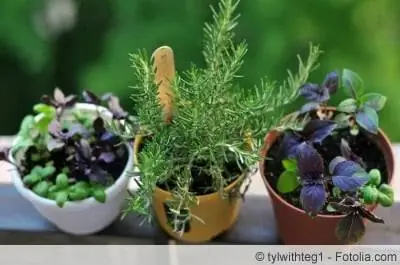
When mismatched herbs are planted next to each other, they hinder each other's growth, a condition that results in a poor harvest. Some of the vigorous varieties quickly cover their neighbors and deprive them of the sunlight that is essential for survival. In some cases, this factor is not immediately apparent because it involves the underground growth of roots competing for space in the soil:
- Marjoram needs distance from oregano
- Basil does not get along well with lemon balm and rue
- Dill has no place next to tarragon, fennel and caraway
- Fennel and caraway don't mix at all
- Chamomile and peppermint don't go together
- Coriander and fennel should not grow next to each other
Mixed cultures
In herb gardens and planters, mixed cultures should always be preferred over monocultures, as one-sided monocultures provide an excellent basis for infestation by many pests. If a pest feels at home in a monoculture, it quickly attacks the entire bed or planter. It is not uncommon for the herbs to die completely when a pest infestation occurs. Certain herbs repel pests and protect neighboring herbs from infestation if the two plants are allowed to grow next to each other. In this way, susceptible herbs are spared from pests and can develop their full splendor undamaged:
- Some herbal scents have a deterrent effect on various pests, e.g. B. Basil
- Certain substances in herbs kill bacteria and fungi
- Herbs can improve soil quality
- However, some types of herbs must be grown alone in order to develop ideally
- Strong-growing varieties need a lot of space or their own containers, e.g. B. Lovage and peppermint
- Also require a lot of space: angelica, lavender, bay leaf, turmeric, wormwood, hyssop and lemongrass
Incompatible herbs
Some types of herbs are incompatible with themselves and therefore need a new location every year, otherwise there will be poor growth and a meager harvest in the second year of planting. The location used first may only be used again after three years:
- Thyme should change its location every year
- The same applies to dill, oregano and parsley
Suitable plant neighbors
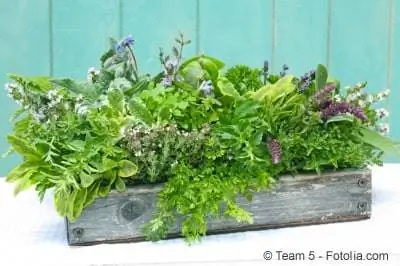
Herbs do not always have to be cultivated together with other herbs; many of the varieties also get along very well with other crops or even with ornamental plants in the garden. In this way, a completely new herb bed does not have to be created, but existing space in the garden can be used for planting herbs. Most herbs are low-consuming plants and, in their natural distribution zones, have mainly specialized in lean, nutrient-poor and often extremely dry locations. This is why herbs harmonize very well with other plants, as they do not represent any competition for nutrient supply:
- Herb essential oils repel pests, bacteria and fungi
- Use the space under tall-growing perennials for herbs, e.g. B. under tomato plants
- Lavender goes well with rose bushes
- Wormwood protects currant bushes from dangerous diseases
- Basil goes perfectly with cucumbers, cabbage and tomatoes
- Dill grows excellently with cauliflower, peas, carrots, beets and lettuce
- Fennel goes ideal with strawberries, lettuce and onions
- Parsley combines well with radishes, radishes and tomatoes
Conclusion
Herbs provide a welcome change to the menu and also give the gardener a unique scent experience. Having your own herb garden is an ideal way to always be able to harvest fresh herbs. If a garden is not available, the herbs you want can also be grown in a planter on the windowsill in the living room or kitchen. However, you shouldn't just plant random herbs next to each other, as many varieties don't get along well or even don't get along at all. In a well-arranged planter, incompatibility becomes apparent very quickly; if plants are placed close together, they must fit together perfectly. A good indication of compatibility is the origin, location requirements and lifespan of the herbs. With good planning and informative background information on each type of herb, they will thrive splendidly, support each other in growth and protect each other from dangerous diseases and pests.

